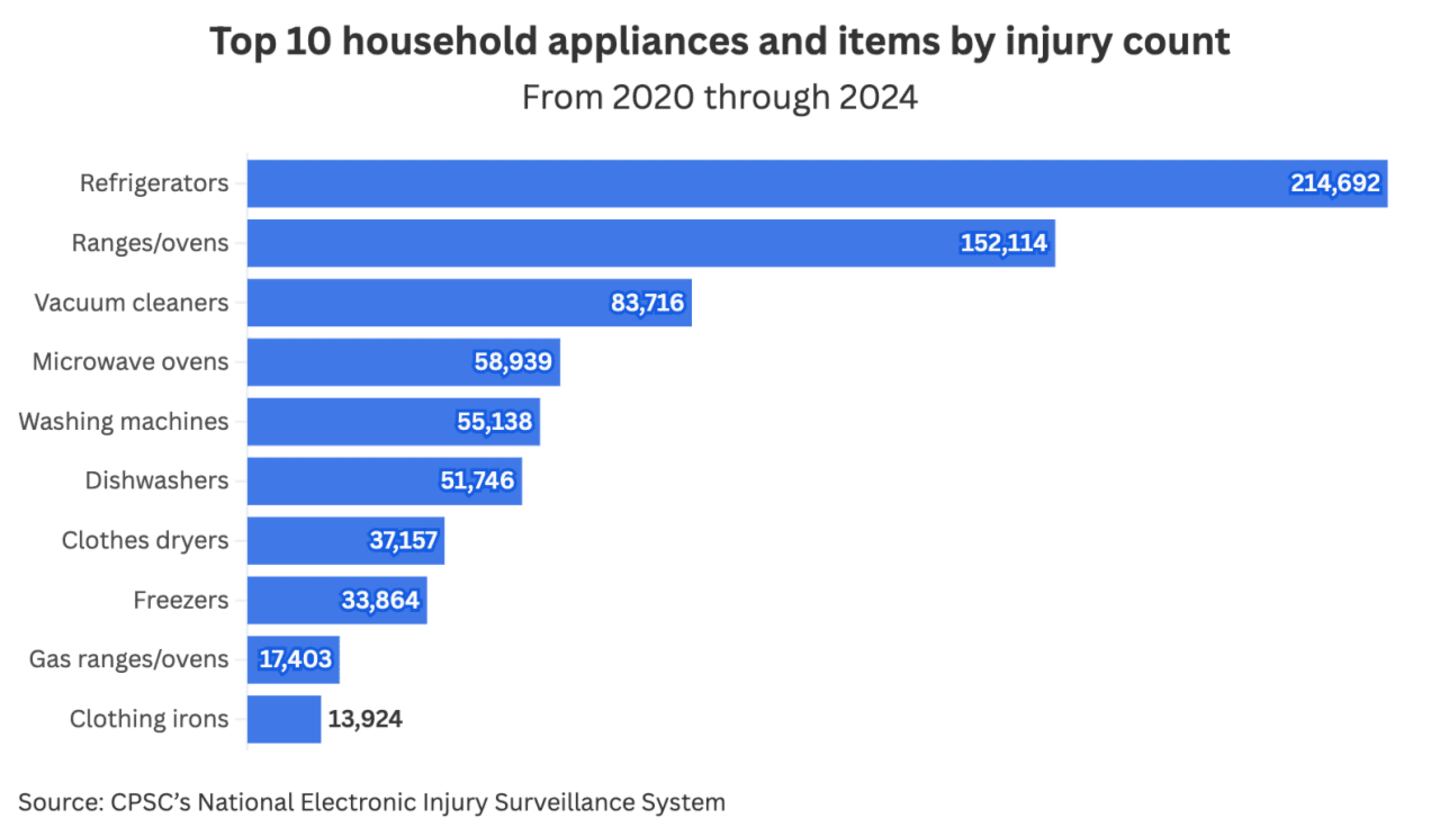The hidden dangers in your home: What the data says about furniture and appliance injuries
Home might feel like your safe space, but the numbers tell a different story. In the past five years, tens of thousands of injuries have been linked to everyday items like kitchen appliances and furniture. These aren't always caused by misuse. They often stem from normal use, unexpected failures, or hidden hazards.
As homes get smarter, it's easy to overlook the potential risks. But devices like ovens, recliners, and dressers still send thousands to the ER each year, according to U.S. Consumer Product Safety Commission (CPSC) data. In this article, CheapInsurance.com breaks down the most injury-prone household items, the types of harm they cause, and what you can do to stay safe.
The most dangerous household appliances and furniture
Data from the CPSC's National Electronic Injury Surveillance System (NEISS) shows how everyday appliances lead to emergency room visits. NEISS gathers information from participating hospitals about consumer product-related injuries happening in the U.S..
From 2020 through 2024, home refrigerators caused the most harm, with over 214,000 injuries reported. Ranges and ovens were next, with more than 152,000 injuries, and vacuum cleaners ranked third, with almost 84,000 injuries over the same time period.
CheapInsurance.com
Microwaves, washers, and dishwashers each led to 50,000+ incidents involving steam burns, electrical shocks, or pinched fingers. Dryers, freezers, and clothing irons also caused tens of thousands of injuries to home users.
The key takeaway of all these numbers is that even familiar appliances come with risks. Knowing which ones cause the most harm can boost awareness and help you use them more safely.
The most common types of injuries caused
The CPSC also tracks the kinds of injuries most commonly caused by household appliances or items. The patterns are surprising.
Fractures are a leading issue with refrigerators (20%) and vacuum cleaners (19%), possibly pointing to falls, tipping, or heavy doors. Lacerations are especially common with dishwashers, making up 42% of injuries, likely from sharp parts or objects. Ranges/ovens, washers, and dryers also show double-digit laceration rates.
CheapInsurance.com
Other appliances bring unique risks:
- Freezers most often cause contusions or abrasions, which are your basic bruises or scrapes.
- Gas ovens show a higher rate of anoxia, which occurs when there's not enough oxygen in the body, which can happen because of gas leaks.
- Sewing machines frequently involve foreign body injuries from embedded needles.
The bottom line is that the appliance matters not just for how often it causes harm but also for how. Understanding the ways in which you could most likely be injured can help you take the right precautions and increase the safer use of these items in your home.
The hidden cost of household injuries
More severe household injuries can land people in the ER and come with a steep price tag. The CPSC Hard Screening Report from 2025 estimates that housewares and kitchen appliances alone account for $3.5 billion annually in preventable injuries and deaths.
It also reported that fires are the deadliest risk, often sparked by unattended cooking or flammable materials near open flames. These accidents pose serious safety risks and can also rack up major costs, from medical bills to home repairs due to property damage.
While preventing injuries is about keeping people safe, it's also a smart financial move. Choosing safer products, using appliances correctly, and keeping up with maintenance can help families avoid both harm and high costs.
How to protect yourself and your family
Most household injuries can be prevented with a few simple steps.
Prevention tips
- Anchor furniture like dressers and bookshelves to prevent tip-overs, especially with kids at home.
- Register new appliances and check the CPSC recall database for safety alerts.
- Follow all safety instructions, especially for electrical and gas-powered items.
- Don't overload power strips, which can spark fires.
- Supervise children around risky appliances and furniture.
If an injury happens
- Get medical help right away.
- Save the product, packaging, and manual.
- Take photos and write down what happened.
- Report it to the CPSC if a defect was involved.
- Contact a product liability attorney if negligence or a faulty product caused the injury.
A little prevention — and quick action — can go a long way in keeping your household safe.
Small steps for a safer home
Everyday items like stoves, dishwashers, and refrigerators can pose real risks, especially if they're misused, poorly maintained, or defective. But most injuries are preventable. Anchor furniture, follow safety instructions, and check for recalls. These small steps make a big difference. To report a hazard or explore further safety data, visit SafeProducts.gov. Prevention starts with awareness, so don't wait for an accident to act.
Methodology
For this study, we leveraged the CPSC's National Electronic Injury Surveillance System (NEISS) to measure which common home appliances and products cause the most injuries. The NEISS provides a sample of injuries occurring around the U.S.; these estimates were then scaled to generate injury estimates.
This story was produced by CheapInsurance.com and reviewed and distributed by Stacker.






